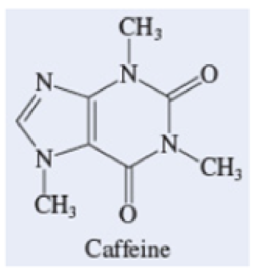
Concept explainers
Caffeine, the stimulant in coffee and tea, is a weak base that ionizes in water according to the equation

A 0.15-M solution of caffeine at 25°C has a pH of 8.45. Determine the Kb of caffeine.
Interpretation:
The
Concept Information:
Base ionization constant:
The ionization of a weak base
The equilibrium expression for the ionization of weak base
Where,
pOH definition:
The
Relationship between pH and pOH
The relationship between the hydronium ion concentration and the hydroxide ion concentration is given by the equation,
As
To Calculate: The
Answer to Problem 16.15WE
Answer
The
Explanation of Solution
Given data:
Caffeine is the stimulant in tea and coffee.
Caffeine is a weak base which ionizes in water as follows,
The pH of the given 0.15 M solution of caffeine is 8.45
Calculation strategy:
Using the given pH, the pOH can be found, then from pOH obtained, the hydroxide ion concentration is calculated.
From the obtained hydroxide ion concentration, use reaction stoichiometry to determine the other equilibrium concentrations, then evaluate
Calculation of pOH:
The pOH can be calculated using the following formula as follows,
Therefore, the pOH of the given caffeine solution is 5.55
Calculation of hydroxide ion:
The hydroxide ion can be calculated as follows,
Therefore, the concentration of
Calculation of
The concentration of hydroxide ion for the given weak base can be found out from its equilibrium reaction with water.
Based on the stoichiometry,
If the concentration of
We summarize the changes as follows,
|
| |||
|
Initial
|
0.15
|
|
|
|
Change
|
|
| |
|
Equilibrium
|
|
| |
Therefore, the base ionization constant
The
Want to see more full solutions like this?
Chapter 16 Solutions
Chemistry: Atoms First
- The quantum yield of the photochemical decay of HI is 2. Calculating the moles of HI per kJ of radiant energy can be decayed knowing that the energy absorbed per mole of photons is 490 kJ.arrow_forwardThe quantum yield of the photochemical decay of HI is 2. Calculate the number of Einsteins absorbed per mole knowing that the energy absorbed per mole of photons is 490 kJ.arrow_forwardThe quantum yield of the photochemical decay of HI is 2. How many moles of HI per kJ of radiant energy can be decayed knowing that the energy absorbed per mole of photons is 490 kJ.arrow_forward
- If the energy absorbed per mole of photons is 450 kJ, the number of Einsteins absorbed per 1 mole.arrow_forwardWhen propionic aldehyde in vapor form at 200 mmHg and 30°C is irradiated with radiation of wavelength 302 nm, the quantum yield with respect to the formation of CO is 0.54. If the intensity of the incident radiation is 1.5x10-3 W, find the rate of formation of CO.arrow_forwardDraw mechanismarrow_forward
- Does Avogadro's number have units?arrow_forwardExplain why the total E in an Einstein depends on the frequency or wavelength of the light.arrow_forwardIf the dissociation energy of one mole of O2 is 5.17 eV, determine the wavelength that must be used to dissociate it with electromagnetic radiation. Indicate how many Einstein's of this radiation are needed to dissociate 1 liter of O2 at 25°C and 1 atm of pressure.Data: 1 eV = 96485 kJ mol-1; R = 0.082 atm L K-1; c = 2.998x108 m s-1; h = 6.626x10-34 J s; NA = 6.022x 1023 mol-1arrow_forward
- Indicate the number of Einsteins that are equivalent to 550 kJ mol⁻¹ of absorbed energy (wavelength 475 nm).arrow_forwardIndicate the number of einsteins that are equivalent to 550 kJ mol⁻¹ of absorbed energy?arrow_forwardA unit used in photochemistry is the einstein. If 400 kJ mol-1 of energy has been absorbed, how many einsteins is this equivalent to?arrow_forward
 Chemistry: Principles and PracticeChemistryISBN:9780534420123Author:Daniel L. Reger, Scott R. Goode, David W. Ball, Edward MercerPublisher:Cengage Learning
Chemistry: Principles and PracticeChemistryISBN:9780534420123Author:Daniel L. Reger, Scott R. Goode, David W. Ball, Edward MercerPublisher:Cengage Learning ChemistryChemistryISBN:9781305957404Author:Steven S. Zumdahl, Susan A. Zumdahl, Donald J. DeCostePublisher:Cengage Learning
ChemistryChemistryISBN:9781305957404Author:Steven S. Zumdahl, Susan A. Zumdahl, Donald J. DeCostePublisher:Cengage Learning Chemistry: An Atoms First ApproachChemistryISBN:9781305079243Author:Steven S. Zumdahl, Susan A. ZumdahlPublisher:Cengage Learning
Chemistry: An Atoms First ApproachChemistryISBN:9781305079243Author:Steven S. Zumdahl, Susan A. ZumdahlPublisher:Cengage Learning
 Introductory Chemistry: A FoundationChemistryISBN:9781337399425Author:Steven S. Zumdahl, Donald J. DeCostePublisher:Cengage Learning
Introductory Chemistry: A FoundationChemistryISBN:9781337399425Author:Steven S. Zumdahl, Donald J. DeCostePublisher:Cengage Learning Chemistry: The Molecular ScienceChemistryISBN:9781285199047Author:John W. Moore, Conrad L. StanitskiPublisher:Cengage Learning
Chemistry: The Molecular ScienceChemistryISBN:9781285199047Author:John W. Moore, Conrad L. StanitskiPublisher:Cengage Learning





